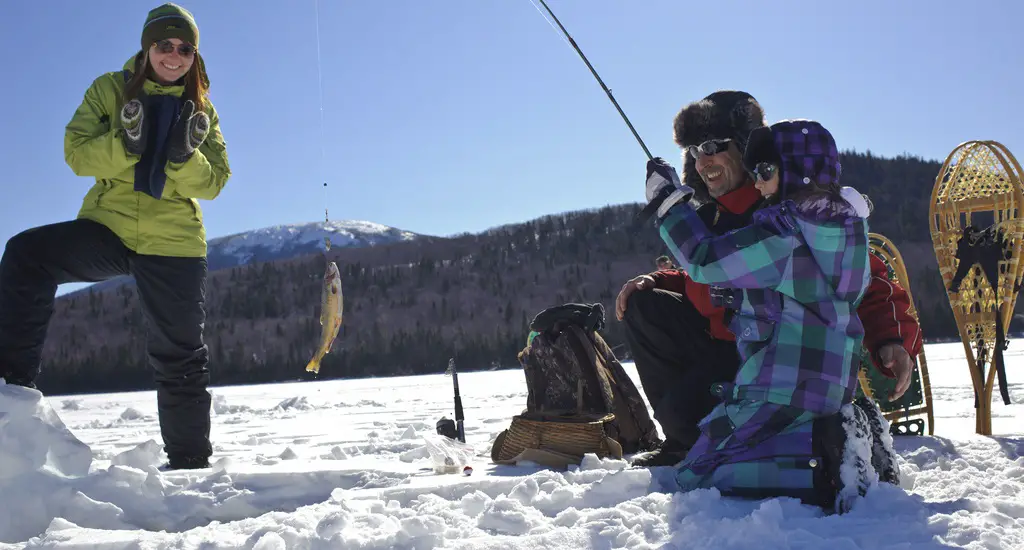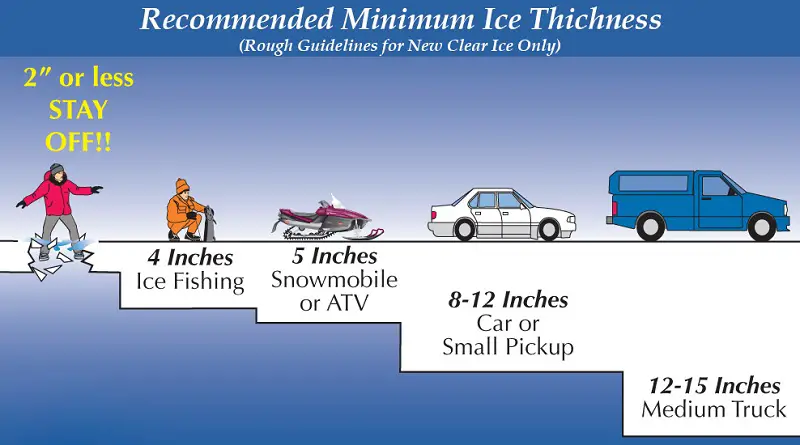Fishing on the ice requires not only different equipment but also tips and tactics than you would use in the summer months.
To take your ice fishing to the next level, make sure to take this advice and apply it on your next fishing trip.

Ice Fishing Tips
As mentioned in the previous section, start out as early as possible. The early bird gets the worm and the first fisherman gets the fish.
Fish often need to maintain a specific body temperature and therefore stay at a certain depth in the water. To know the specific depth of the fish you are seeking, either ask your local experts or look online.
Don't make any more noise than you have to. Obviously, to break a hole in the ice and set yourself up, you will have to make some noise. But, the quieter you can be, the less likely you will scare the fish away.
Do not move too quickly. Just like us in the winter months, fish are less likely to expend effort, preferring to conserve as much energy as possible. Keep your bait steady and you will have a better chance of attracting fish.
Take a friend or two. This has two advantages. First, it is much safer (see the following section). Second, if you find one fish in an area, you are more likely to find more. Therefore, it is easier to cover a wide range of locations with multiple people. Once one of you finds a fish, get close together, even next to each other (make sure to stay at least 6 feet away to minimize chances of falling through the ice) to catch more.
Ice Fishing Tactics & Hacks
Don't fish in the same spot all day. Move around and use your Sonar Fish Finder. The sonar will be able to work through the ice, so you can cover a large amount of ground fairly quickly. But, if you want a visual look, you will need to drill a hole. Go with a partner to cover more ground
Focus on the Bases of Drop-offs and Depressions
In colder weather, fish are more active in deeper water. Many fish also accumulate near the base of drop-offs near gathered sediment because of a higher likelihood of insect spawning. Therefore, if you find a drop-off with your depth finder, take special care to look for fish in these areas.
Small holes or depressions in the body of water's floor are often warmer, contain food, and therefore attract fish. Also, keep a close eye on these areas.
When lowering a jig, practice vibrating your wrist quickly, but in a small motion. These vibrations, which Dave Genz calls "pounding" will also vibrate the jig. If you do this while slowly raising your rod up and down in a vertical motion, this will cause a motion in the jig attractive to fish. By doing this you are making the jig seem alive and increasing your chances of catching a variety of species.
Don't Skip: Ice Fishing Safety

Safety is the most important aspect to consider with ice fishing. Unlike the warmer months, in the cold of winter, making even a small mistake can have very dangerous consequences when compounded with the effects of bitter cold.
Bring a Friend
Take a friend. It is wise never to go out fishing alone, even in areas that you know well. If something happens, it is always good to have someone on hand to either help or call someone who can.
Communicate
Let someone else know where you are going and how long you plan on being gone. Therefore, if an accident occurs, authorities know where to find you and can often salvage a bad situation from becoming much worse.
Dress in Layers
It is often smart to bring more than you think you need just in case it is colder than expected or something gets wet. Make sure your outer layer is waterproof as well in case of wind. Also, make sure to protect your extremities. Thick socks and gloves can save you from high levels of discomfort
Bring an Ice Safety Pick
Just in case you fall through the ice, a safety pick can help you get a grip on the slippery ice and avoid drowning or hypothermia. If you or your friend fall through the ice, make sure to get them into a heated area and into dry clothes as soon as possible.
Check with Local Authorities
Local authorities can often tell you which areas are safe to fish in and which areas you should avoid. They will also be able to tell you what to do in case of an emergency and which authorities to contact for help.
Conclusion
In conclusion, ice fishing can be an exhilarating and rewarding experience when approached with the right techniques and precautions. By starting early, paying attention to depth, minimizing noise, moving slowly, and bringing a friend, you can significantly increase your chances of success.
Additionally, employing tactics such as being mobile, focusing on drop-offs, and mastering the vibrating jig can enhance your fishing strategy. Above all, prioritize safety by dressing in layers, bringing a friend, communicating your plans, and using an ice safety pick.
With these tips in mind, you're well-equipped to enjoy a productive and safe ice fishing adventure.

